Eddie Firth and I have been visiting the old Barn Bluff mine for years. At first glance there isn’t a lot to see. But a close look reveals a lot of history. The most evocative reminder of its history is a few grainy photos. Some show men proudly staring at the camera. They are frozen in a moment of time long gone, but they bring life to the distant past.
Mine manager CP Smith (top) at a Barn Bluff Copper Company open cut (Photo F Noetling 19071)
The Barn Bluff copper mine was remote when it was active. That hasn’t changed nor has the wild weather that comes from the west.
General location of Barn Bluff copper mine – bottom left (modified List map)
History
The short life of the mine began in 1898 when copper-stained rock was discovered on a hill near an unnamed creek in the Barn Bluff area.2 It was ignored. A year later it was rediscovered.3 In May 1900, it was formally claimed by CP Smith.4 The Barn Bluff Copper, Gold and Silver Mining Company was floated in August 1900 to provide the cash for working the mine.5 The investors were largely from Hobart and Franklin. Within six months, the hill had been probed by trenches and open cuts. Copper rich ore outcropped everywhere. The miners were packed into a few tents. The only solid shelter was a blacksmith’s hut.
The mine looked good but more money was needed to prove it by driving long tunnels into the hill. Machinery and labour, and money to pay for them, was required. The support came in April 1901, when the Barn Bluff Option Development Association was formed in Adelaide.6 The machinery was ordered in May.7 In July 1901 three huts were built.8, 9
At first the tunnelling was done with pick, shovel and brute force. By November 1902, 320 feet had been driven though solid rock. 10, 11
The machinery finally stirred at the end of January 1903. Water spun a Pelton water turbine into life and it drove an air compressor. The air powered rock- drills.12 Within six months another 130 feet had been cut.13 Then work stopped and the mine was abandoned.
Hut Hunting
I’d been to the copper mine a few times but in 2010, Eddie showed me things I hadn’t seen before; a water race, bits of pipe, a machinery site and a flume. He also took me along the old Barn Bluff Track to a hut site marked by stones and a rusting shovel.
A decade later, Eddie found an old Pelton wheel in a shed near Cradle Mountain. Could it have come from the mine? We wrote about it here. It wasn’t clear. But could we match it to the wooden foundations of the Pelton wheel at the Barn Bluff mine?
In 2022, I was lucky to spend three days at the mine with Jenny Cook. We really had time to scour the whole area. We returned to the hut site and searched for the other structures shown in the old photo below.
Wards Pinnacle and the huts – 1907 (F Noetling)14 Wards Pinnacle – 2022 (P Brown 2022)
We thought that we found another one. But nothing else. A year later, I went back. At the end of a long frustrating day, I found the rock chimney butts of the missing huts.
Overview
Finding the huts told us about what the miners needed in their accommodation. The weather seemed to be a big factor. The area had revealed its unforgiving nature from the very beginning. The prospectors, CP Smith and Cook, where snow bound in their tents for five days when they first explored the site in May 1900.15 When they returned in the summer of that year the weather was ‘of the roughest description’.16
The huts were built a short distant from the bottom of the eastern side of the hill containing the copper ore. This gave them protection from the worst of the weather which came from the west. Being in the valley would also reduce the wind. By avoiding being at the very foot of the hill would allow a lot more afternoon sun.
The huts were a few minutes’ walk from the miners’ workplace in the tunnels. Water came from nearby Commonwealth and Cook Creeks.

Nothing has been written about how the huts were built or who lived in them. But looking at the remains allows us to assume that the first one found was the manager’s. The others were two workers’ huts and a small store.
Manager’s Hut
The manager’s hut was a little way down the track from the mine. It would have stood as a neat hut in a small clearing beside a gully. It would have had commanded views of the valley and of the workers’ huts. The door was on the sunnier northern side of the hut. It also had a window, which is evidenced by a few shards of flat thin glass found at the site.
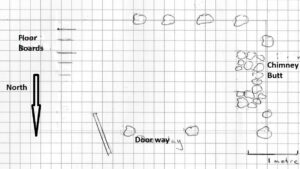
The site was levelled by a build-up of soil and a line of support rocks at the western end to support the floor logs. The floor would have been wooden palings, some of which survive. The hut was about 2 metres wide and 4 metres long, warmed by a small fire place at the western end. Two lengths of neatly squared structural timber show the care made with its construction. A rougher hut would have used round spars. This is consistent with a call by the mine for ‘a good sawyer’ at the time that the huts were to be built.17
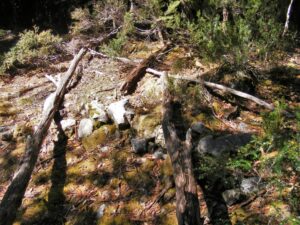
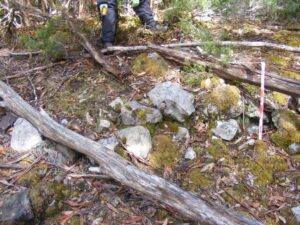
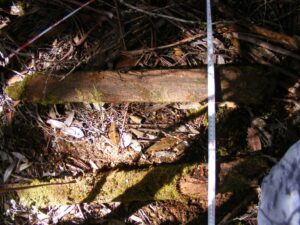
The Workers’ Huts
From the manager’s hut, the workers’ huts were beyond a small gully and on a rise. The only features were two substantial, and very overgrown, chimney butts. The northern slope of the rise had been levelled to form the platforms for the huts. The separation, and alignment of the chimneys was the same as in the old photo. However, there was no sign of the smaller structure between the two huts in the old photo. It would seem that these huts also had north facing doors taking advantage of a sunnier aspect.


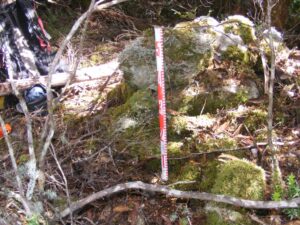
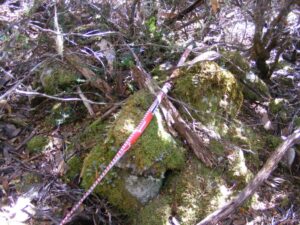
What Else?
Only a few artefacts of the Barn Bluff mine have survived the ravages of time. But the written record, and some intriguing features at the site, tease us with the possibilities. Hints of shapes under the leaf litter may be able to be interpreted and bring some more life to this once busy, albeit brief, mine.
One example is at least three levelled areas cut into the slope of the hill near the main tunnel. What was built on them? May be one held the blacksmith’s shop built in 1900. We’ll go to the newspapers reports of the day to tell more stories in blogs.
Remember Eddie’s Pelton wheel? Jenny and I did measure up the wooden structure that held the Pelton Wheel at the mine. Does it match Eddie’s? We’ll go into that very soon too.
Copyright Peter Brown 2023
1 F Noetling, Report on the Copper Mining Propositions Held by the Association. 1907, Mineral Resources Tasmania, Report 07_0010.
2 G Waller, Report on the mineral districts of Bell Mount, Dove River, Five Mile Rise, Mount Pelion and Barn Bluff, Government Geologist’s Office. Launceston, 31 Apr 1901.
3 Mineral Resources Tasmania, Lincoln 1/20, mineral Lease 3992/93M TJ Connolly, instructions given 24 Apr 1899.
4 Mercury, 26 May 1900.
5 Examiner, 4 Aug 1900.
6 Advertiser, 4 Apr 1901.
7 Tasmanian News, 17 May 1900.
8 Tasmanian News, 15 Jun 1901.
9 Examiner, 8 Jun 1901.
10 31 Jan 1903, Mercury 4 Feb 1903.
11 14 Oct 1901.
12 13 Dec 1902.
13 Tasmanian News, 22 Jul 1903.
14 Noetling, as above.
15 Zeehan and Dundas Herald, 22 May 1900.
16 Mercury 25 Dec 1900.
17 Mercury, 22 May 1901.
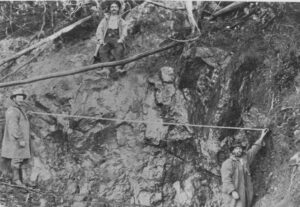


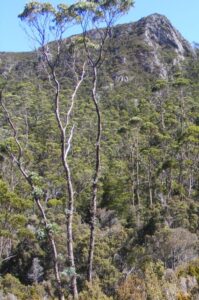
I love this stuff keep doing it please.
thanks David, certainly will